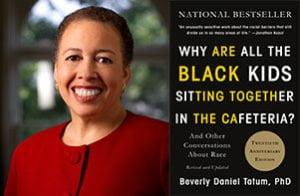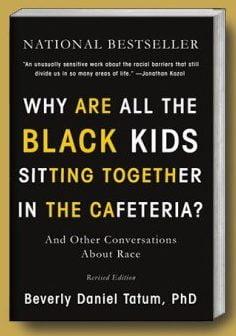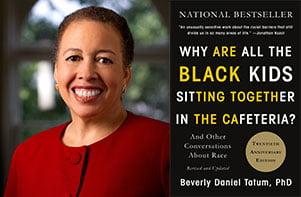Why Are All the Black Kids Sitting Together in the Cafeteria? And Other Conversations About Race
by Scott Jaschik 12/01/2017 Beverly Daniel Tatum’s 1997 book on race relations — Why Are All the Black Kids Sitting Together in the Cafeteria? — has become a modern classic in college and high school classrooms, used to educate and prompt healthy discussions among young people about race. Tatum, a psychology scholar, stepped down as president of Spelman College in 2015. Her first major project after leaving administration was updating the book — still relevant but with the original version missing the elections of Presidents Obama and Trump, the Black Lives Matter movement, and the police shootings that prompted the movement and galvanized many black youth. The new version of Why Are All the Black Kids Sitting Together in the Cafeteria? was released this week by Basic Books.
Beverly Daniel Tatum’s 1997 book on race relations — Why Are All the Black Kids Sitting Together in the Cafeteria? — has become a modern classic in college and high school classrooms, used to educate and prompt healthy discussions among young people about race. Tatum, a psychology scholar, stepped down as president of Spelman College in 2015. Her first major project after leaving administration was updating the book — still relevant but with the original version missing the elections of Presidents Obama and Trump, the Black Lives Matter movement, and the police shootings that prompted the movement and galvanized many black youth. The new version of Why Are All the Black Kids Sitting Together in the Cafeteria? was released this week by Basic Books.
Tatum responded via email to questions about the new edition:
Read full interview at Inside Higher Ed
Q: Many studies show that K-12 schools are now more segregated than they were a generation ago. How much does such segregation limit understanding of one another, and how much does it complicate race relations in higher education?
A: Because of persistent K-12 school segregation, colleges and universities are among the few places where people of different racial, cultural and socioeconomic backgrounds can engage with each other in more than just a superficial way. However, because of both lack of direct contact and repeated exposure to cultural stereotypes while growing up, cross-group interactions can be uncomfortable. Even genuine efforts at friendship and connection can be derailed by awkward interactions and unconscious bias. Ideally, the college years offer a unique opportunity to engage with people whose life experiences and viewpoints are different than one’s own and to develop the leadership capacity needed to function effectively in a diverse, increasingly global, world. However, whether college students develop that capacity will depend in large part on whether the institution they attend has provided structures for those learning experiences to take place. Intentionality matters.
Q: You discuss the issue of white identity, and yet many scholars who talk about white people as a group get slammed these days — it seems to be something of a third-rail issue. Why do you think it’s important to talk not just about black identity but white identity?
A: In a race-conscious society, we all have a racial identity that develops in predictable ways, shaped largely by the interactions we have with others. An understanding of that identity-development process can help all of us begin to build bridges across lines of difference. With that understanding, we are better able to do what I call the ABCs of leadership — affirm identity, build community and cultivate the 21st-century leadership we all need to dismantle the racism that threatens our diverse society.
Q: Several times since the original version of your book, we have seen major court rulings that left some thinking that affirmative action was a resolved issue (at least legally), and yet it keeps coming back, most recently with the Trump Justice Department investigating allegations of discrimination. You note that many people of different races have very different conceptions of affirmative action. How can educators promote better understanding of what affirmative action is and isn’t?
A: Because many people are confused about the basic facts of affirmative action, I thought it important to provide that information in my book, and I would urge educators to familiarize themselves with it. I provide a brief overview of the history of affirmative action policies, going back to the introduction of the term in 1965, distinguishing between quotas (which are illegal) and measurable goals (which are necessary for evaluating progress). A recent national survey indicated that as many as 50 percent of whites believe that discrimination against whites has become a problem equivalent to that against people of color, despite the fact that national data show that whites as a group consistently fare better on all measures of social or economic well-being (i.e., access to housing, education, employment, health care). Helping readers understand the differences between commonly held perceptions and measurable realities is what I have tried to do in the book, and what informed educators can do in the classroom.
Q: You end the book on an optimistic note, discussing encouraging projects. You, of course, went to press before Charlottesville and President Trump promoting the idea that there were good people “on many sides” there. Has your optimism been challenged by recent events?
A: There is no question that we are living in a difficult time, and recent events in Charlottesville and elsewhere have been very disturbing. I work at maintaining my optimism because I believe that in times of darkness, we all need to generate more light. The epilogue is titled “Signs of Hope, Sites of Progress,” because we all need to remember that each of us can exercise the kind of inclusive leadership we need to interrupt the cycle of racism. With the collective hard work and effort of many, I still believe positive social change is possible.

The classic, bestselling book on the psychology of racism—now fully revised and updated.
Walk into any racially mixed high school and you will see Black, White, and Latino youth clustered in their own groups. Is this self-segregation a problem to address or a coping strategy? Beverly Daniel Tatum, a renowned authority on the psychology of racism, argues that straight talk about our racial identities is essential if we are serious about enabling communication across racial and ethnic divides. These topics have only become more urgent as the national conversation about race is increasingly acrimonious. This fully revised edition is essential reading for anyone seeking to understand the dynamics of race in America.
Beverly Daniel Tatum, Ph.D. is president emerita of Spelman College and in 2014 received the Award for Outstanding Lifetime Contribution to Psychology, the highest honor presented by the American Psychological Association. She lives in Atlanta, Georgia.
[arve url=”https://www.youtube.com/embed/2DTVj8SfDek” /]
 Beverly Daniel Tatum’s most popular work outlines racial identity development and the challenges with having meaningful conversations on race. In order to engage the reader in self-reflection to have such conversations, Tatum uses practical examples from her experience as a parent and a college professor. She highlights conversations she has had with her own children about race and racism, as well as teaching activities she has used and discussions she has facilitated to engage her college students in recognizing, understanding, and embracing their racial identity.
Beverly Daniel Tatum’s most popular work outlines racial identity development and the challenges with having meaningful conversations on race. In order to engage the reader in self-reflection to have such conversations, Tatum uses practical examples from her experience as a parent and a college professor. She highlights conversations she has had with her own children about race and racism, as well as teaching activities she has used and discussions she has facilitated to engage her college students in recognizing, understanding, and embracing their racial identity.
In the first section of the text, Tatum draws attention the term racism. She distinguishes between prejudice and racism, by describing prejudice as preconceived judgments or opinions made with limited information. Prejudice is considered a consequence of cultural racism, where images and messages affirm assumed White superiority and assumed inferiority of non-Whites, also referred to as People of Color. Racism is then considered to be a system, where some received advantage based on race (see Portraits of White Racism, David Wellman). While somewhat late in the discussion of racism, Tatum does acknowledge the social construction of race and how the complexity of defining race presents a challenge when defining one’s multiple identities and their intersections.
The next sections of the text outline the racial identity development of Blacks (those in the U.S. as a result of slavery) and Whites (those of European ancestry). Drawing on the work of Cross (1991) and Helms (1990), Tatum answers the question, “Why are all the Black kids sitting together in the cafeteria?” Simply, in late adolescence and early adulthood, young African-Americans recognize the personal impact of racism and develop an identity which opposes anything White. This oppositional social identity is designed to protect young Blacks from the psychological assaults of racism and to keep the dominant group (Whites) away (Fordham & Ogbu, 1986). Followed by this is stage, an intense immersion/emersion into one’s own history and culture takes place. This immersion/emersion is supported by same-race peers, hence why all of the Blacks are sitting together.
While many young African- Americans are transitioning through these two of five stages where they are considering what it means to be Black, young Whites (and some not so young) are not considered what it means to be White. In the contact stage of White development, many would describe themselves as “just normal”. They have no recognition or understanding of the systemic advantages afforded to them because of their race and view racism as only individual acts committed by a few extremists. University settings can provide an opportunity for some Whites to transition into the stage where there is acknowledgement of systemic racism and White privilege. This is a difficult stage for many Whites, seeing both injustice and privilege, and many move to “blaming the victim” versus moving on to unlearning one’s racism. Lumped in with White racial identity development is a conversation on affirmative action. Tatum presents many of the fears and misunderstandings many Whites have about the Executive Order issued by Lyndon B. Johnson to remedy the history of discrimination against men and women of color, White women, and later those with disabilities and veterans.
Though it is a very small section Tatum acknowledges that racial/ethnic identity development is more than Black and White. For Native, Latino, and Asian Americans ethnic identity development is complex, given the wide range of experiences and diversity within these groups. Given the projected population increases for both Latino and Asian populations, it may prove beneficial for social science researchers and development theoriet to spend more time looking beyond Black and White. Along these lines the increase in biracial identity births and multiracial families warrants additional conversation as well. Tatum points out the need to challenge the notion forcing biracial children to choose a monocultural identity. Instead, caring individuals should promote self-acceptance of a multiracial heritage. This is also essential for multiracial families, by way of adoption, where White parents must be willing to experience their Whiteness and address the racism that their family will experience. Again more time could be spend looking at the complexities of multiracial families in relation to moncultural ones.
To end, Tatum focuses on how to embrace and continue cross-racial dialogue. To find the courage to have cross-racial conversations and promote social change begins with educating ourselves. Next we should recognize we cannot fix everything, so concentrate on your sphere of influence. Additionally, the interruption of racism will be a long-term commitment, so honest conversations with White children in particular must be had to engage with their curiosity about race. Remaining silent will not protect them or lead to colorblindness (see the work of Phyllis Katz). Adults must not shy away from the questions children have about physical differences because children are forming biases whether we think they are or not. By dismissing their questions, because of our uneasiness, we are teaching that conversations on race are to be avoided. This inaction by adults only helps to fuel the segregated cafeterias seen in middle and high schools and even on college campuses.
Racial biases are formed early. However by breaking the silence (and using children’s literature) we can help to adjust the views of children.
Works Cited
Cross, W. E. (1991). Shades of black: Diversity in African-American identity. Philadelphia, PA:
Temple University Press.
Fordham, S. & Ogbu, J. (1986). Black students’ school success: Coping with the burden of
‘acting white’. Urban Review, 18, 176-206.
Helms, J. E. (1990). Black and white racial identity: Theory, research, and practice. Westport,
CT: Greenwood.
Tatum, B. D. (1997). “Why are all the black kids sitting together in the cafeteria?”: And other
conversations about race. New York, NY: Basic Books.




No Comments so far
Jump into a conversationNo Comments Yet!
You can be the one to start a conversation.Only registered users can comment.